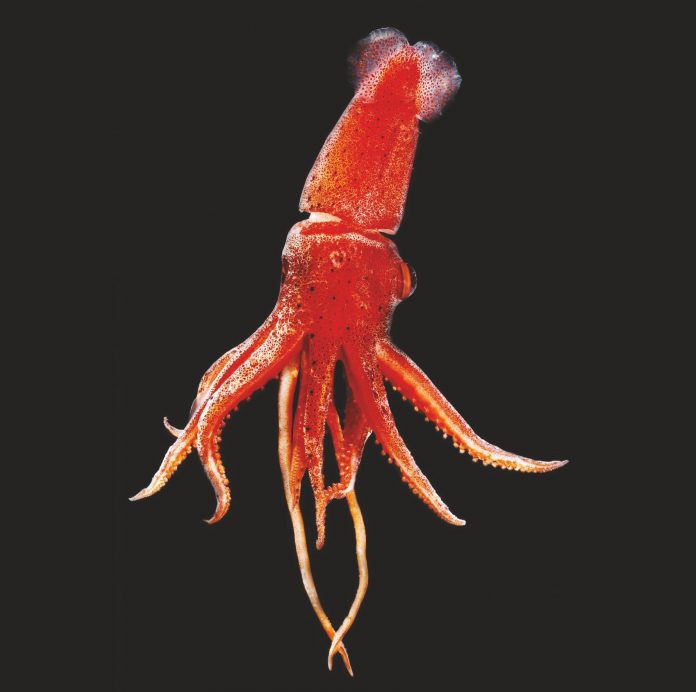Efraim Harari
The squid belongs to a group of marine mollusks called cephalopods. The octopus and cuttlefish are also included in this group. The word cephalopod means “head-foot” and describes how the limbs of these sea creatures seem to be attached directly to their heads. Although all cephalopods have quite a few arms, not all cephalopods have tentacles.
Tentacles are long, flexible, muscular organs that are primarily used for grabbing and catching prey. Tentacles are retractable (can be drawn in) and have a flattened tip that is covered with suckers, which work like suction cups. Arms, in contrast, have suckers along their entire length, not just their tip. The squid has both types of limbs, arms and tentacles.
Most species of squids have ten limbs: eight arms and two tentacles. (The cuttlefish has the same amount of arms and tentacles as the squid, while the octopus does not have any tentacles; it simply has eight arms.) The squid’s two tentacles are much longer than its arms. For example, the giant squid’s arms can grow to ten feet in length, while their tentacles can grow to forty feet long!
Quick Draw
The Humboldt squid can shoot out its tentacles in twenty milliseconds, which is almost faster than the human eye can see!
A Closer Look At…
How the Squid Uses Its Tentacles to Catch Prey
 There are over three hundred species of squids. Many are small, slim creatures, but the giant squid and the colossal squid can both grow to over forty feet long, making them the largest invertebrates (animals without backbones) in the sea.
There are over three hundred species of squids. Many are small, slim creatures, but the giant squid and the colossal squid can both grow to over forty feet long, making them the largest invertebrates (animals without backbones) in the sea.
Most squids snatch their prey with their pair of extendable tentacles, which are usually hidden from view but can shoot out at lightning-fast speed. The squid will either sneak up on its prey or chase it, before wrapping its powerful tentacles and strong arms around it. The suckers on the squid’s tentacles and arms give it a secure grip, preventing the prey from escaping. Once the squid latches onto its prey, it rapidly brings it in toward its sharp beak.
However, not all squids have suckers on their tentacles. Some have hooks instead. The Humboldt squid has a combination of both suckers and hooks; the hooks are hidden inside the suckers. But all squids are predators and will use their suckers and/or hooks for the same thing: hunting.
A squid’s diet includes crustaceans, fish, and even other squids. Large squids will attack sharks, too, by wrapping their tentacles around the shark and strangling it.
Torah Connection
The fourth plague that Hashem unleashed upon the Egyptians was Arov, a mixture of wild beasts. In this plague, all sorts of wild animals from different parts of the world descended upon Mitzrayim and attacked the Egyptians. Some of the animals included in this plague were lions, tigers, bears, wolves, horses, snakes, birds of prey, biting insects, and rodents.
In an attempt to protect themselves from the terrifying beasts, the Egyptians locked themselves inside their homes. However, one of the beasts included in Arov, a giant sea creature called the silonis (according to others, it was called the sironis), made sure to foil the Egyptians’ escape plan…
This creature is described as having numerous arms, each of which was fifteen feet long. It traveled through the streets of Mitzrayim and reached its long arms into the roofs of the Egyptians’ homes, tearing open the rafters and ceilings, and breaking open the locks on the doors. This allowed the other animals to enter the homes and attack the Egyptians. (Sefer Hayashar, Ch. 80)
There are varying opinions as to the identity of this great sea creature. One opinion, given by Rav Aryeh Kaplan, describes this terrifying creature as a squid.
It is interesting to note that the name silonis most likely comes from the word silon, which means “pipe.” This would describe this sea creature as an animal with pipes, or tentacles, which is exactly what the squid is!
A Little Riddle
Q: How many tickles does it take to make a giant squid laugh?
A: Ten-tacles!



